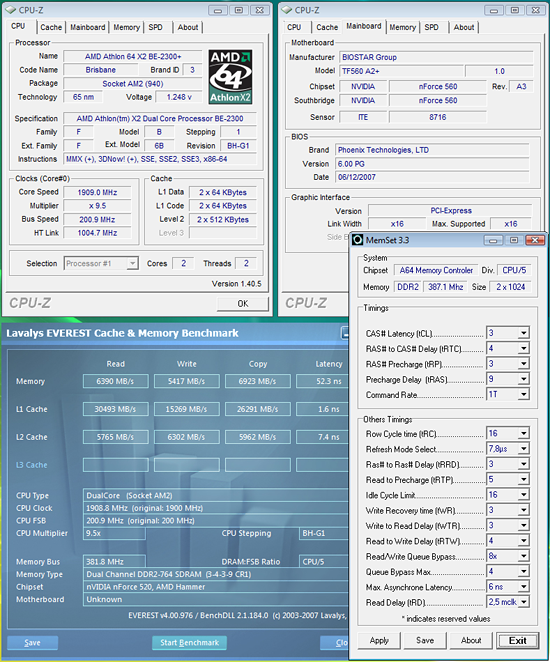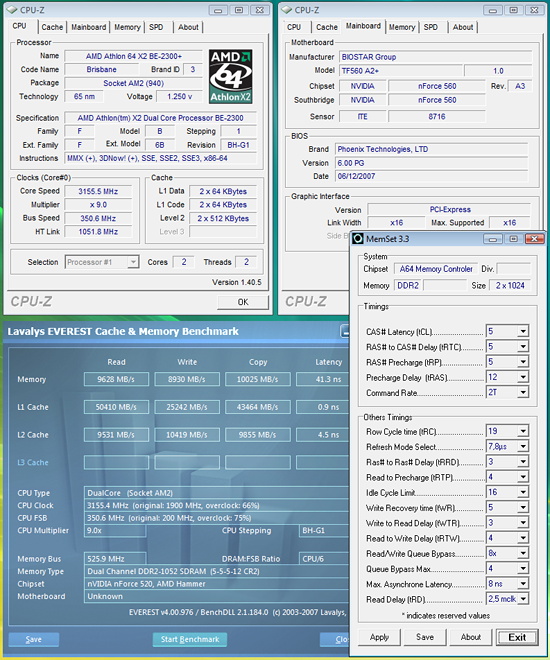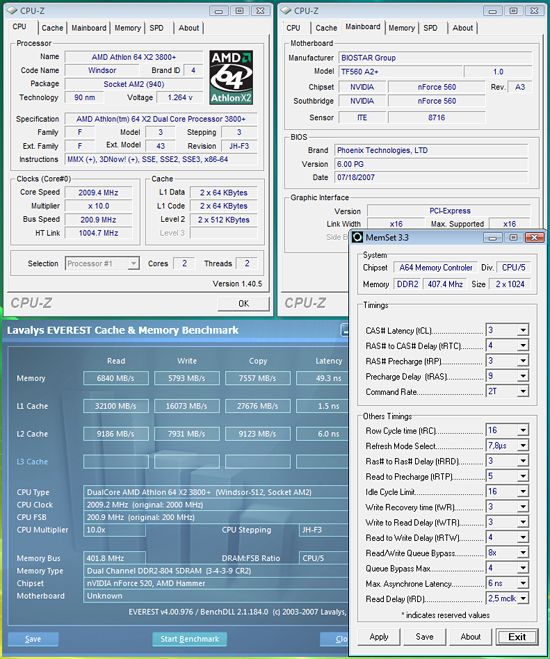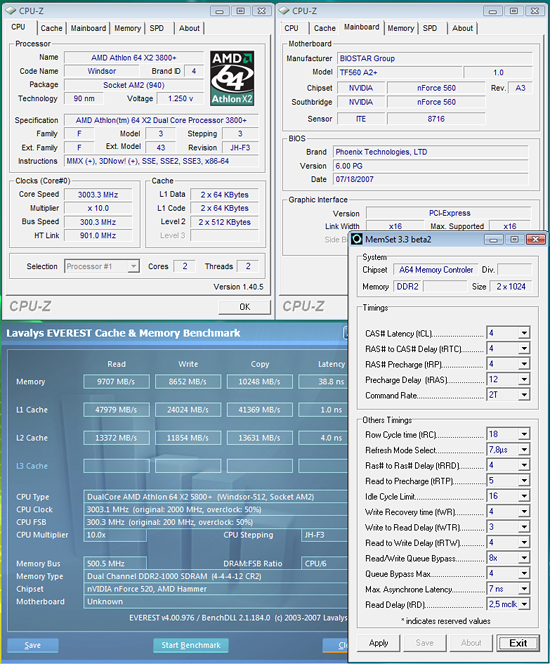Biostar TF560 A2+: Overclocking NVIDIA's new nForce 560
by Gary Key on August 2, 2007 12:15 AM EST- Posted in
- Motherboards
AM2 Overclocking
X BE-2300 - Stock - 200x9.5
X2 BE-2300 - OC - 333x9
Our BE-2300 was able to reach a final setting of 333x9 with the stock cooler. CPU voltage had to be increased to 1.408V, chipset voltage to 1.300V, and memory to 2.15V in order to maintain full stability throughout our benchmark testing that included 24 hours of dual Prime95. We just received a new performance 0801 BIOS that allows us to reduce CPU voltage to 1.37V with the chipset voltage increased to 1.325V for the same settings. We found during testing that keeping tRC settings to 22 or less allowed us to run fairly aggressive CAS and tRAS timings with our OCZ HPC memory at both stock and overclocked settings. We were able to pass all benchmarks except for Quake 4 with tRAS set at 10 and tRC at 19 when overclocking.
X2 BE-2300 - Max OC - 350x9
We turned our stock cooler in for a Tuniq 120, increased chipset voltage to 1.325V, and CPU voltage to 1.450V to reach a final 350HTT setting that was extremely stable during testing. Of note, our processor will actually do 3258MHz (362x9) on our ASUS CrossHair board but any HTT settings above 350 resulted in benchmark errors on our TF560 sample. The board would POST and enter Vista 64 at 365HTT but was not stable in most benchmarks or stability tests.
X2 3800+ - Stock - 200x10
X2 3800+ - OC - 300x10
Although the Windsor based X2 3800+ is being phased out, the chips are still plentiful and priced at an incredible bargain of $65. We received the new F3 stepping but unfortunately we have a CCBVF 0706 lot number that did not afford us the same overclocking results we are seeing in lot numbers of CCB8F 0715 and beyond now. We just received our first CCB8F 0715 and it has already clocked to 3.4GHz on 1.475V. We will have full test results with this particular CPU in our next overclocking article.
In the meantime, our current X2 3800+ is the runt of the liter and would not even POST past 310x10. It did not matter what clock multiplier we utilized or how much voltage was pumped through this particular sample; we always ended up around 3GHz as its stable limit. With that in mind, we determined a final setting of 300x10 with memory set at DDR2-1000 offered the best overall performance. Our final CPU voltage was at 1.450V, chipset at 1.300V, and memory at 2.15V.
| Biostar TF560 A2+ Overclocking Testbed |
|
| Processor | AMD X2 BE-2300, (1.9GHz, 2x512KB Cache) AMD Athlon 64 X2 3800+, (2.0GHz, 2x512KB Cache) |
| CPU Voltage | B-2300 1.40V (default 1.230V) X2 3800+ 1.45 (default 1.35V) |
| Cooling | Retail Air Cooling |
| Power Supply | Seasonic S12 II 380W |
| Memory | OCZ Reaper HPC PC2-6400 (2x1GB) |
| Video Cards | 1 x MSI 8800GTX |
| Hard Drive | Western Digital 150GB 10,000RPM SATA 16MB Buffer |
| Case | Cooler Master CM Stacker 830 |
| Maximum CPU OC | B-2300 - 333x9 (4-4-4-12, 1000MHz, 2.15V), CPU 1.408V 3003MHz (+58% CPU, +67% FSB) X2 3800+ - 300x10 (4-4-4-12, 1000MHz, 2.15V), CPU 1.450V 3003MHz (+50% CPU, +50% FSB) |
| . | |
X BE-2300 - Stock - 200x9.5
 |
| Click to enlarge |
X2 BE-2300 - OC - 333x9
 |
| Click to enlarge |
Our BE-2300 was able to reach a final setting of 333x9 with the stock cooler. CPU voltage had to be increased to 1.408V, chipset voltage to 1.300V, and memory to 2.15V in order to maintain full stability throughout our benchmark testing that included 24 hours of dual Prime95. We just received a new performance 0801 BIOS that allows us to reduce CPU voltage to 1.37V with the chipset voltage increased to 1.325V for the same settings. We found during testing that keeping tRC settings to 22 or less allowed us to run fairly aggressive CAS and tRAS timings with our OCZ HPC memory at both stock and overclocked settings. We were able to pass all benchmarks except for Quake 4 with tRAS set at 10 and tRC at 19 when overclocking.
X2 BE-2300 - Max OC - 350x9
 |
| Click to enlarge |
We turned our stock cooler in for a Tuniq 120, increased chipset voltage to 1.325V, and CPU voltage to 1.450V to reach a final 350HTT setting that was extremely stable during testing. Of note, our processor will actually do 3258MHz (362x9) on our ASUS CrossHair board but any HTT settings above 350 resulted in benchmark errors on our TF560 sample. The board would POST and enter Vista 64 at 365HTT but was not stable in most benchmarks or stability tests.
X2 3800+ - Stock - 200x10
 |
| Click to enlarge |
X2 3800+ - OC - 300x10
 |
| Click to enlarge |
Although the Windsor based X2 3800+ is being phased out, the chips are still plentiful and priced at an incredible bargain of $65. We received the new F3 stepping but unfortunately we have a CCBVF 0706 lot number that did not afford us the same overclocking results we are seeing in lot numbers of CCB8F 0715 and beyond now. We just received our first CCB8F 0715 and it has already clocked to 3.4GHz on 1.475V. We will have full test results with this particular CPU in our next overclocking article.
In the meantime, our current X2 3800+ is the runt of the liter and would not even POST past 310x10. It did not matter what clock multiplier we utilized or how much voltage was pumped through this particular sample; we always ended up around 3GHz as its stable limit. With that in mind, we determined a final setting of 300x10 with memory set at DDR2-1000 offered the best overall performance. Our final CPU voltage was at 1.450V, chipset at 1.300V, and memory at 2.15V.










21 Comments
View All Comments
chesterman86 - Sunday, August 5, 2007 - link
any one knows which boards will work with am2+ processorsi've a evga 590sli, with a x2 4200. it will be great if i could upgrade to a phenom =D
anyway, even if i do the bios update, i'll not have ht3 right?
lopri - Saturday, August 4, 2007 - link
Thanks for the great review. The board reviewed looks solid and the coverage is, as usual, complete and clear. I always liked BioStar's boards and felt their products are not getting much spotlight among enthusiasts. The board and NV's new chipset looks solid and it's really amazing that how much computing power we get for the dollars these days.Said that, I'd like to know if Gary thinks the review samples are representative enough for retail products that one can buy, when it comes to overclocking? I haven't kept up with AMD's latest steppings and the overclocking performance of the reviewed CPUs is simply amazing. I remember the time when a 3.0GHz A64 was considered a golden.
lopri - Saturday, August 4, 2007 - link
Forgot to ask: What is the thing that going for NF560? There was a brief mention regarding GPU optimazation and PCI-E lane configuration, but overall it looks almost identical to NF550. If one were to buy a either similarly priced NF550 board or NF560 board, what would differentiate 560 from 550?CrystalBay - Thursday, August 2, 2007 - link
That is some incredible value right there .Thanks for the article G.K.!!!
Powered by AMD - Thursday, August 2, 2007 - link
Why do you use a U$S 100 Motherboard with the Intel setup and a U$S 80 one for the AMD?If we are in the cheap setup, i would like to make a comparision apples to apples.
I think if you use the U$S 85 JetWay J966GDAG-PB, the tables should be much different.
yyrkoon - Friday, August 3, 2007 - link
You try finding a decent enough Intel motherboard for under $100. Most people I know wouldnt even settle for less than a $150 + board concerning an Intel system. In-expencive/good AMD motherboards with a decent feature list have been around for a while, open your eyes, and do a product search of your own . . .crimson117 - Thursday, August 2, 2007 - link
Good point!
Also, the processors costs are not equal... (newegg prices)
Athlon 64 X2 3800+ costs $65
AMD X2 BE-2300 costs $90
Intel E2160 costs $95
AMD Athlon 64 X2 6000+ costs $170
So the AMD setup would be $50 cheaper for about equal performance.
DeepThought86 - Thursday, August 2, 2007 - link
2 PATA ports supproted but only one implemented on this board. Boo, hiss. So Biostar saves $0.50 and we're out $100 buying a new driveelpresidente2075 - Thursday, August 2, 2007 - link
All I have to say is: You've gotta move forward sometime. PATA is OK if you like slow, bulky, and outdated interfaces, but if you're into the whole "having a decent computer" thing, you're gonna have to spend the money anyway.And if you mean that you've just purchased a large PATA drive and don't want to purchase a new SATA one, I pity you and your short-sightedness. PATA is going the way of the Dodo, and SATA is the future for now.
Good luck with the new drive!
LoneWolf15 - Saturday, August 4, 2007 - link
This one made me laugh.
Not because PATA isn't an old interface. But, compare the speeds of a modern PATA drive to an SATA drive, and you'll find almost no difference. The interface isn't the bottleneck; the drive mechanics are. For that reason, an UltraATA Seagate 7200.10 and a SATA Seagate 7200.10 are within a hairsbreadth in performance.
SATA certainly cables nicer than PATA, and getting rid of the whole master/slave configuration is a great thing too. But you're buying into the hype a little too heavily. Until we can improve drive mechanics to both increase data throughput and decrease latency in more than tiny incremental steps, the interface won't matter all that much.